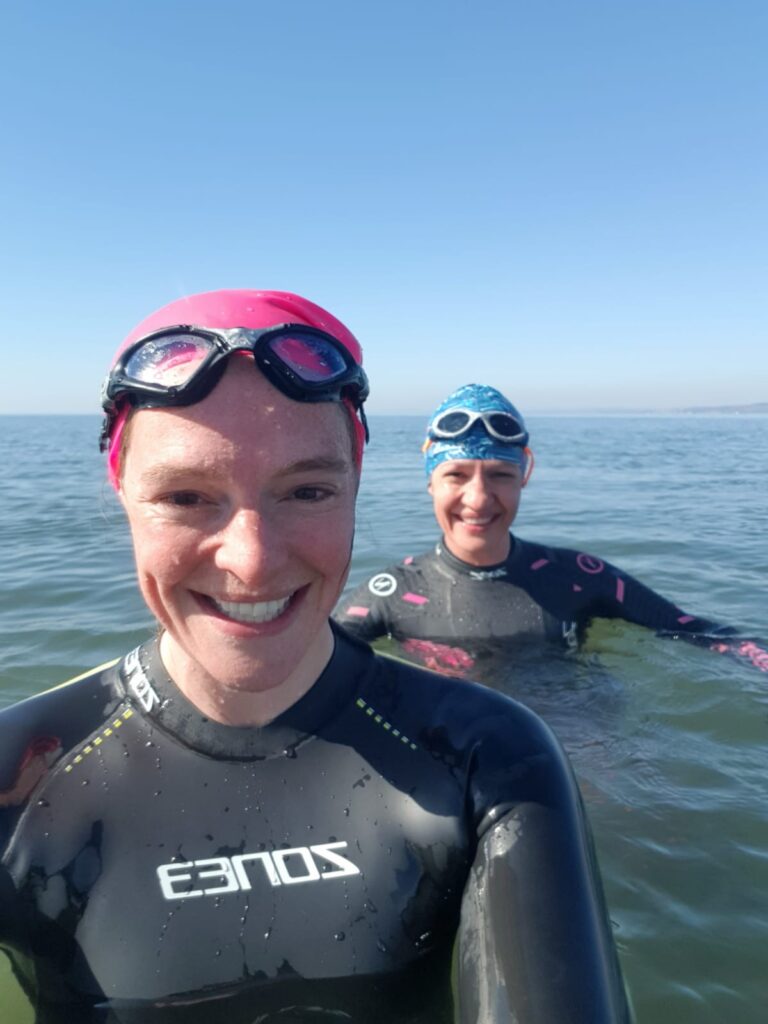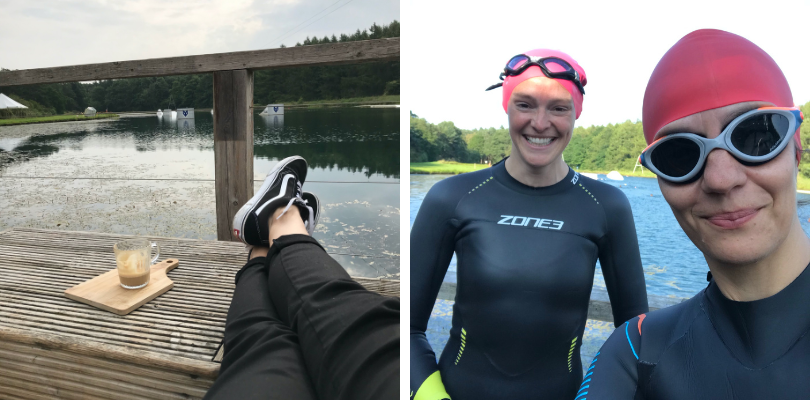Everybody’s doing it. Dooking, dipping, dunking, swimming, whatever you want to call it, chances are that you or someone you know has been jumping (or tentatively tip-toeing) into seas, rivers, lochs or waterfalls this past year.
Wild swimming saw a phenomenal resurgence during the pandemic with record numbers of people taking to it during the first lockdown. That trend shows no signs of abating even now that swimming pools have reopened. At Edinburgh Life With Kids we have embraced the craze.
Why go wild swimming?
There are so many different motives for wild swimming. For some it is the sheer exhilaration that comes with cold water immersion. It feels amazing and leaves you buzzing! Others are there for the health benefits, of which there are said to be many. Research shows that cold water acts to reduce inflammation in the body, potentially improving the impact of diseases caused by chronic inflammation. Anecdotally, swimmers report a reduction in pain from arthritis, for example. Some say that their skin conditions have radically improved and others say they’ve had fewer colds since they started swimming. Regular immersion may even protect the brain from degenerative diseases.
Mental well-being is one of the main reasons people take to the water. Problems seem to melt away when you’re (literally) immersed in nature and the endorphins released can last all day. Others have found a sense of community draws them to the water. Wild swimming groups have been popping up all Scotland and many new friendships have been forged over a post-swim cuppa. Others have used wild swimming purely for the exercise. Perhaps as part of a training regime that used to involve regular pool swims, now difficult to get booked into. For some it’s the attraction of a new challenge, or to see what all the fuss is about and there’s no denying that some people are there for the ‘gram!
Whatever the reason people start, wild swimming seems to be utterly addictive so be warned that once you’ve been a few times you will soon be getting up early to swim, scoping out swim spots on holiday and dragging everyone you know down to the beach. Or maybe that’s just us…
Edinburgh’s best wild swimming spots
Edinburgh has a number of swim spots that are generally safe, accessible and well populated by the city’s swimmers.
1. The main beach at Portobello is an obvious choice. The water is monitored for bathing quality and there are some excellent cafes for a post-swim coffee to warm up. People swim at points right along the length of the beach but swimmers can almost always be found opposite the swimming pool or going in from the steps at the Joppa end of the promenade. Beware of bashing a knee when swimming over the groynes (the wooden structures that jut out into the water) when they’re hidden at high tide.
2. Wardie Bay at Granton is now a hugely popular spot. Sheltered by the breakwater, Wardie is almost always calm (waves can be enormous with an easterly wind but that is infrequent) and the water is easy to reach even at low tide. More serious swimmers make a beeline for the various buoys in the Bay but there are always people bobbing around near the beach. Best to swim to the right side of the breakwater to avoid the boats and occasional seals on the harbour side. This is a small beach and can get very busy at popular times.

3. Further round the shore it is possible to swim at South Queensferry with the iconic backdrop of the various bridges across the Forth. This spot is best around an hour either side of high tide. It has heavier boat traffic than Edinburgh’s other beach options and can also have strong currents so not ideal for inexperienced swimmers and I wouldn’t take kids here.
4. Freshwater fans are best to head to Threipmuir reservoir in the Pentlands. A big body of water, this one allows for longer swims and is popular with triathletes in training. Nearby Harlaw reservoir is less frequented by swimmers, having more anglers and a much steeper drop- off in depth than Threipmuir. As with any reservoir, it is important to avoid the machinery and be aware of other water users.
5. Not far from Edinburgh, East Lothian has an abundance of beautiful beaches that are perfect for swimmers. Gullane and Seacliff are two favourites and we make regular trips to the open water swimming sessions at Foxlake at Dunbar.

It is also worth mentioning Edinburgh’s worst wild swimming spots: the water quality at Cramond is questionable due to sewage overflows released into the River Almond. It is also miles to the water at low tide so overall this one is best avoided. Fisherrow Sands at Musselburgh gets mixed reviews. It was declassified by SEPA in 2019 due to consistently poor bathing water quality and current advice is not to swim there within 1-2 days of heavy rainfall due to pollution flowing in. It can however offer a good alternative when the weather has been dry beforehand.
How to get started
All you really need to do is put your swimming costume on, get down to your nearest water source, get in and have fun. It’s that simple (but do please heed the safety advice below).
You don’t need a wetsuit, but might prefer to wear one. Edinburgh’s coastal water temperature is up at around 17°C right now and the reservoirs will be even warmer. No judgement for whether you go “skins” or in a wetsuit. I do both.
Neoprene gloves and socks are not essential but will definitely take the edge off the cold and make for a more comfortable swim. If you’ll be putting your head in the water and swimming front crawl then a bright swim cap and goggles are essential but a lot of people prefer heads up breaststroke or just bobbing about. Again, this is all fine!
We recommend keeping your first dip short. Take a minute or two to enter the water slowly and let your body adapt before swimming. Remember to breathe! It will start to feel warmer once you get used to the feel of the water but don’t be tempted to stay in for too long. How long is too long varies so much from person to person (and even day to day depending what you have had to eat, if you’re especially tired etc.) that it’s impossible to give a guide time. The only rule is to err on the side of caution. Build up to longer swims, don’t feel pressure to stay in because your friend is. Get out before you feel you have to and read up on the after-drop phenomenon.
When you do get out, take off your wet clothes and get dried and into warm clothes as quickly as you can. You don’t need a fancy changing robe, though if you do keep swimming through the cold months then they are a great piece of kit!
Safety first
- Don’t swim alone. There are Facebook groups for every region of Scotland dedicated to finding local swim buddies if none of your friends or family will accompany you. For Edinburgh check out The Wild Ones (Portobello) and Wardie Bay Wild Ones (Granton).
- Always carry out your own risk assessment before swimming: check the weather and tide times in advance; survey the water for any odd rip currents or obstructions; ensure you have a safe point of entry and exit.
- Cold water shock can take your breath away so enter the water slowly and take a minute to allow your body to adapt.
- Wear a brightly coloured swim cap and consider bringing a tow float for added visibility (and to put your phone/keys/valuables in) if you are in a shared body of water or planning to swim out from the shore. Paddle boarders, kayakers, jet skiers and fishermen are a regular sight off Edinburgh’s beaches and you want them to know you’re there.
- The biggest risk is hypothermia. Don’t stay in the water too long.
- Air temperatures are high just now but if swimming in the colder months be sure to bring a few layers of clothing with you to put on afterwards. A wooly hat, a flask with something warm to drink and a small snack will all help you to warm up safely if you do get too cold.
- In the summer time there are jellyfish in Scotland’s seas. The majority are harmless and deliver only a mild sting but some people can react badly and the red coloured lion’s mane jellyfish can give you a nasty sting.
- There is an obvious risk of drowning. The sea can be unpredictable so if you aren’t a strong swimmer, stay within your depth and swim parallel within easy reach of the shore.
See you at the beach!
Wild swimming has become a big part of my life. I swam throughout the winter – when there was snow on the beach and ice on the reservoirs – and now that it’s summer the whole family has got involved. We have been in highland lochs and waterfalls, Fife tidal pools and beaches the length and breadth of the country. It’s a whole new watery world and I’m so pleased that we jumped on the wild swimming bandwagon. Whether it’s your first time or you’re a seasoned swimmer, there’s always more to explore. Happy swimming.


